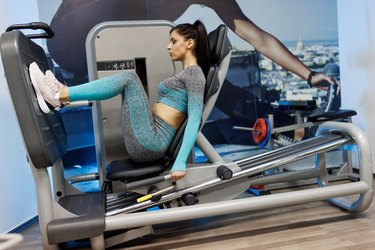
While the leg press machine is a top pick for many gym-goers looking to build strong quads and glutes, it's not uncommon to experience leg press knee pain, especially if you have an injury, use too much weight or have improper form.
Pain, while exercising or immediately following, is cause for concern. Finding out why you're experiencing discomfort can help you prevent and treat any potential injuries.
Video of the Day
Video of the Day
Here are some common concerns that could be causing your pain and tips for protecting your knees when you use the leg press.
1. You Could Have Cartilage Damage
"During the phase of the leg press that involves deep knee flexion, the stress goes to the posterior aspect of the knee, or back of the knee, and the bones and cartilage in the back of the knee," orthopedic surgeon and sports medicine specialist David Geier, MD, tells LIVESTRONG.com.
Often, that area is where cartilage damage and other structural damage like meniscus tears are found, Dr. Geier says. "Applying a large amount of stress to that part of the knee can cause pain in someone with early arthritis or other injuries."
Knee injuries can involve any of the tendons, ligaments or bursae surrounding your knee joint, as well as the bones, cartilage and ligaments that form the joint, according to the Mayo Clinic.
Fix It
If you’re experiencing nagging knee pain that won’t go away — during or after you leg press — talk to your doctor, especially if you can’t bear weight on your knee, you’re experiencing swelling in and around the knee or you can't fully extend or flex your knee, according to the Mayo Clinic.
2. Your Form Could Use Some Work
If you feel knee discomfort on the leg press machine, you might be doing it with improper form. Leg press form mistakes put unnecessary strain on your knees, which may cause pain or injury, according to the American Council on Exercise (ACE).
Fix It
Check your form in the mirror or ask a workout buddy to observe your movements. Here's a refresher, according to the ACE:
- Start sitting with your back flat against the machine's backrest.
- Place your feet flat on the resistance plate about shoulder-width apart with your knees at about 90-degree angles.
- Hold the handles and engage your core.
- Exhale and press through your feet to push the plate away from you until your legs are straight, but don't lock your knees.
- Pause here for a second, then slowly bend your knees to return to the starting position.
3. You're Using Too Much Weight
Another way to leg press without knee pain is to make sure you're using an appropriate amount of weight. Beginners should typically start with about 50 to 75 percent of their body weight. Heavier weight might put undue strain on your muscles and joints that could be painful.
Fix It
Start with lighter weight and perform more reps until you see how this exercise feels for you and your knees, Dr. Geier says. “If you do have knee pain from a prior injury or just wear and tear from years of being active, consider not going as deep with the exercise,” he adds.
FAQ
Common Questions
Is the leg press safer for knees than squats?
“Generally speaking, the leg press is safer than many other knee exercises, especially leg extensions,” Dr. Geier says. That's because the leg press is a closed-chain exercise, which means your feet stay planted on the plate of the machine the entire time.
Squats also require you keep your feet planted on a fixed surface (the floor). “This allows for both your quads and hamstrings to contract, protecting the knee during the motion,” Dr. Geier says.
Both exercises are safe for knees, but squats will work your glutes and hamstrings more than a seated leg press.
Should you wrap your knees to do leg presses?
You don't have to, but if you're lifting heavy, knee sleeves or wraps can help protect the knee joint and may limit pain or discomfort, according to the National Academy of Sports Medicine.
What exercises can you do instead of leg presses?
In addition to the squat, you can also try other leg press alternatives like lunges, deadlifts, rear-foot elevated split squats and wall sits. Cardio machines like stationary bikes and ellipticals are also gentle on sore knees.
Was this article helpful?
150 Characters Max
0/150
Thank you for sharing!
Thank you for your feedback!